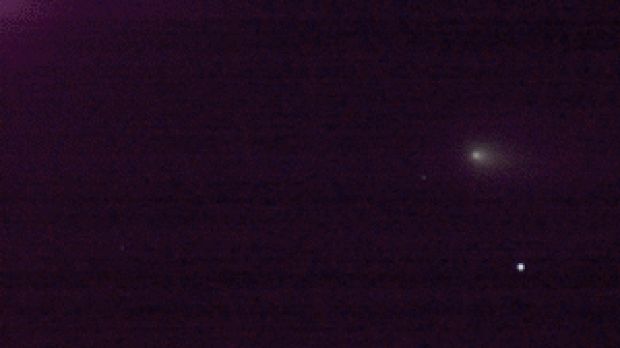In spite of various doomsday worries, the fragments of the Comet 73P Schwassmann-Wachmann 3 are not going to hit the Earth. "We are very well acquainted with the trajectory of Comet 73P Schwassmann-Wachmann 3", said Donald Yeomans, manager of NASA's Near-Earth Object Program Office. "There is absolutely no danger to people on the ground or the inhabitants of the International Space Station, as the main body of the object and any pieces from the breakup will pass many millions of miles beyond the Earth".
None of the comet's fragments will come closer than 8.9 million km to Earth (i.e. more than 20 times the distance from the Earth to the Moon) during its closest approaches, May 12 - 28. The comet started to disintegrate in the fall of 1995 and astronomers are fascinated by it (or them) each time it returns near the Sun. The fragments have been labeled alphabetically, A, B, C, D, etc., fragment C being the largest and, presumably, the principal remnant of the original comet. It will pass closest to Earth on May 12, at a distance of approximately 11.7 million km.
This comet was first discovered in 1930 by the German astronomers Arnold Schwassmann and Arno Arthur Wachmann while they were searching for asteroids. The comet had passed then within 9.3 million km of the Earth (only 24 times the Earth-Moon distance). Although the comet orbits the Sun every 5.4 years, it was not seen again until 1979. The comet was missed in 1985 but has been observed every return since then.
The second time the comet approached the Sun, since it had started to disintegrate in 1995, only two fragments, C and B, were identified to be among the ones originally detected. And now, astronomers have observed many more additional fragments, suggesting that the disintegration continues. Nobody really knows how many fragments will survive this trip around the Sun.
"Thanks to NASA's Hubble Space Telescope astronomers have an unprecedented opportunity to study the demise of a comet nucleus", writes Yvette Smith from NASA. "Hubble's images reveal that a hierarchical destruction process is taking place, in which fragments are continuing to break into smaller chunks. Several dozen 'mini-fragments' are found trailing behind each main fragment, probably associated with the ejection of house-sized chunks of surface material that can only be detected in these very sensitive, and high-resolution, Hubble images."
"Sequential Hubble images of the B fragment, taken a few days apart, suggest that the chunks are pushed down the tail by outgassing from the icy, sunward-facing surfaces of the chunks, much like space-walking astronauts are propelled by their jetpacks. The smaller chunks have the lowest mass, and so are accelerated away from the parent nucleus faster than the larger chunks. Some of the chunks seem to dissipate completely over the course of several days."
Astronomers don't really know what exactly caused the disintegration of the comet. Generally speaking, a comet can be broken down either by gravitational tidal forces, when they pass near large bodies (the way comet Shoemaker-Levy 9 was torn to pieces when it skirted near Jupiter in 1992, prior to plunging into Jupiter's atmosphere two years later), or by the internal thermal stresses, caused by their approach to the Sun (they may "explosively pop apart like corks from champagne bottles due to the outburst of trapped volatile gases", writes Yvette Smith).
This disintegration, occurring without any major cause, makes some astronomers doubt the solidity and stability of all comets. "Catastrophic breakups may be the ultimate fate of most comets", says planetary astronomer Hal Weaver of the Johns Hopkins University Applied Physics Laboratory, who led the team that made the recent Hubble observations and who used Hubble previously to study the fragmentations of comets Shoemaker-Levy 9 in 1993-1994, Hyakutake in 1996, and 1999 S4 (LINEAR) in 2000.
Animated gif: ScottF from Slooth Forum Picture: Hubble's Advanced Camera for Surveys image of the disintegration of Comet 73P/Schwassmann-Wachmann 3's fragment B. Credit: NASA, ESA, H. Weaver (APL/JHU), M. Mutchler and Z. Levay (STScI)

 14 DAY TRIAL //
14 DAY TRIAL // 
